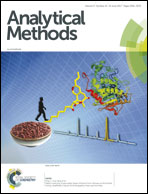Enabling lateral transport of genomic DNA through porous membranes for point-of-care applications†
Abstract
Paper-based nucleic acid diagnostics have the potential to translate laboratory assays to simple-to-use, point-of-care devices, but many prototypes of these systems still lack the ability to process realistic samples due to the inability of genomic-sized DNA to move through membranes with small pores. For applications involving pathogen or human gene identification, the ability to fragment and transport DNA would provide more options for device design and broaden the range of applications. To address this challenge, we have developed and characterized a method that combines cell lysis with DNA fragmentation to allow for lateral transport of genomic DNA through commonly-used porous membranes. Additionally, we demonstrate that varying heating time and temperatures allows for control of both lysis and fragmentation based on genome size. These data align with previously published models that describe both DNA denaturation and thermal scission. This level of control allows semi-selective transport of pathogenic DNA, which can reduce the amount of interference from non-target human DNA in downstream applications. This method can be easily automated and is rapid, occurring in less than 10 minutes with one user step.



 Please wait while we load your content...
Please wait while we load your content...